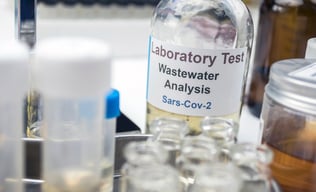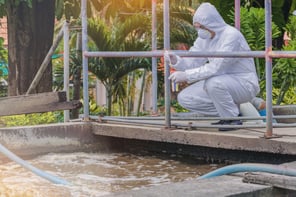In addition to testing individuals for COVID-19 exposure during the pandemic, researchers across the globe have identified other means for tracking its spread—including through wastewater.

Traces of SARS-CoV-2 were detected in wastewater early on, prompting curiosity about how it may be useful in providing earlier indication of the virus and mitigating spread.
Using wastewater to gather data on COVID-19’s presence and transmission rate could offer many benefits, including a more cost-effective method for surveying a community; a means for collecting data from people who lack access to healthcare; and potentially supplying health officials with information faster than traditional testing practices.
Historically, wastewater has been used to monitor other viral diseases, including poliovirus, norovirus and hepatitis A, providing useful insight into a community’s health and response.
Putting it into Practice
In August 2020, the University of Arizona screened wastewater from every dorm on campus as students returned. After detecting the virus in one sample, the university tested the 311 students who lived in the associated dorm and found two asymptomatic students who tested positive. That early detection allowed for those students to be quarantined and avoid far spread.
Across the state of Ohio, cities are participating in wastewater testing under the state’s Coronavirus Wastewater Monitoring Network, formed as a collaboration between the Ohio Department of Health, the Ohio Environmental Protection Agency, the U.S. Environmental Protection Agency, the Ohio Water Resources Center, and others.

“Research in the U.S. and elsewhere has shown that non-infectious RNA (ribonucleic acid) from the virus that causes COVID-19 (SARS-CoV-2) can be excreted in the feces of both symptomatic and asymptomatic infected people and can be detected in wastewater as many as three to seven days before those infections lead to increases in case counts or hospitalizations,” according to the Ohio Department of Health.
“As such, monitoring raw wastewater in sewage collection systems can provide an early warning of disease increase in a community. Community and public health leaders can use this early warning information to make decisions about protective actions to help limit further spread of the disease before cases begin to occur.”
The Future of Wastewater Testing
While research is ongoing, cities across the world continue to implement new wastewater testing methods in hopes of identifying cluster areas and assessing a community’s progression or regression without solely relying on sometimes costly, inaccessible or lengthy swab tests. If successful, it also presents a much more efficient option for evaluating a community: it’s faster and easier to test an entire dorm or neighborhood using wastewater than it is to gather hundreds of people for individual tests. And there is still much to be discovered about wastewater’s role generally in aiding in our response to the COVID-19 pandemic.
“Unlike with polio, public-health officials cannot yet respond to an increase in cases with a vaccine,” according to a study in Nature Biotechnology. “But when vaccines become available, wastewater surveillance could speed their deployment to areas where upticks are detected. Even now, it could facilitate social distancing interventions before community transmission reaches exponential growth and could help governments mitigate the socioeconomic consequences of extended lockdowns.”
Wastewater systems are crucial to the health and wellbeing of a community. Learn more about the basics of sewer maintenance and upkeep by requesting Envirosight's free guidebook:

